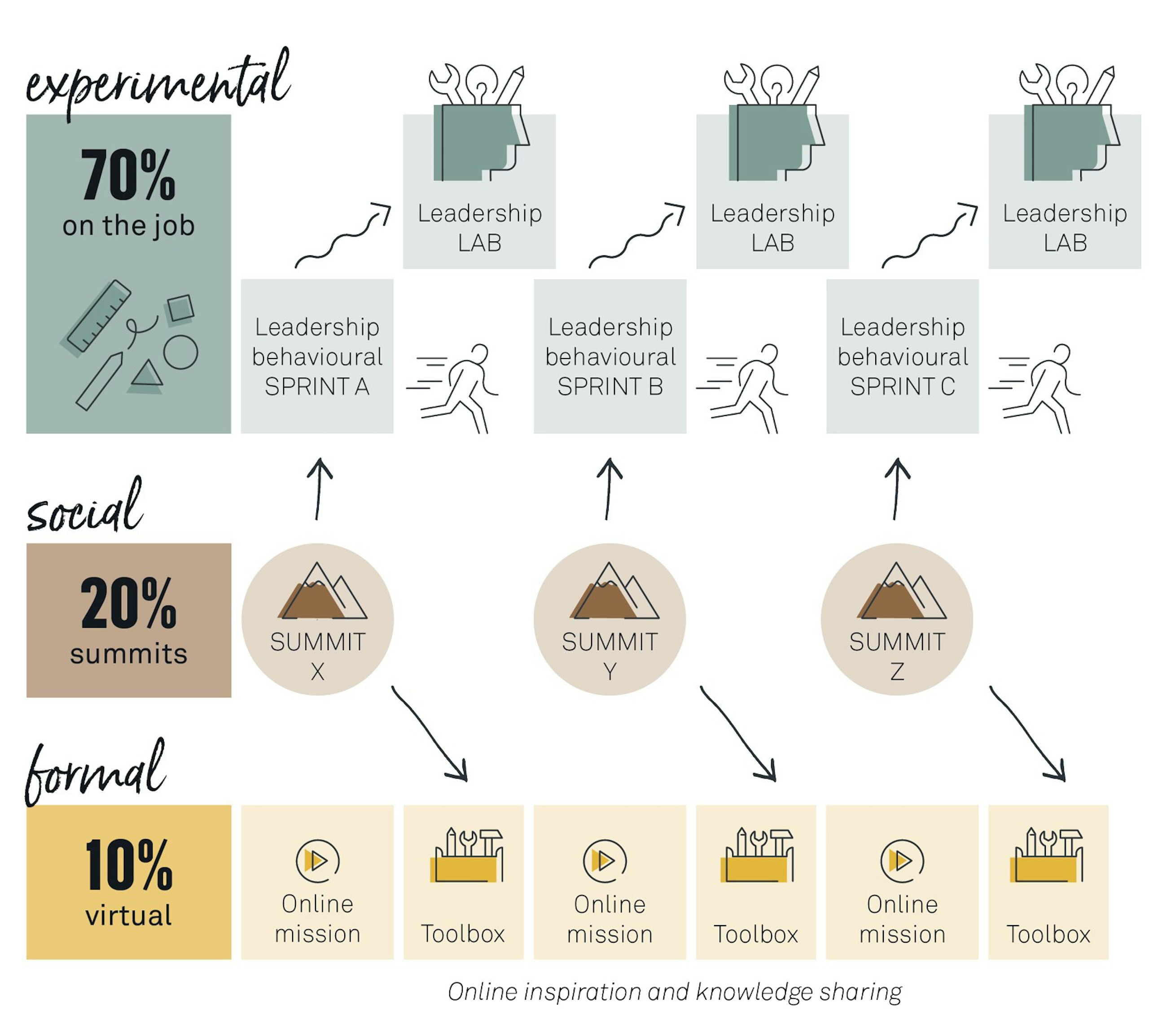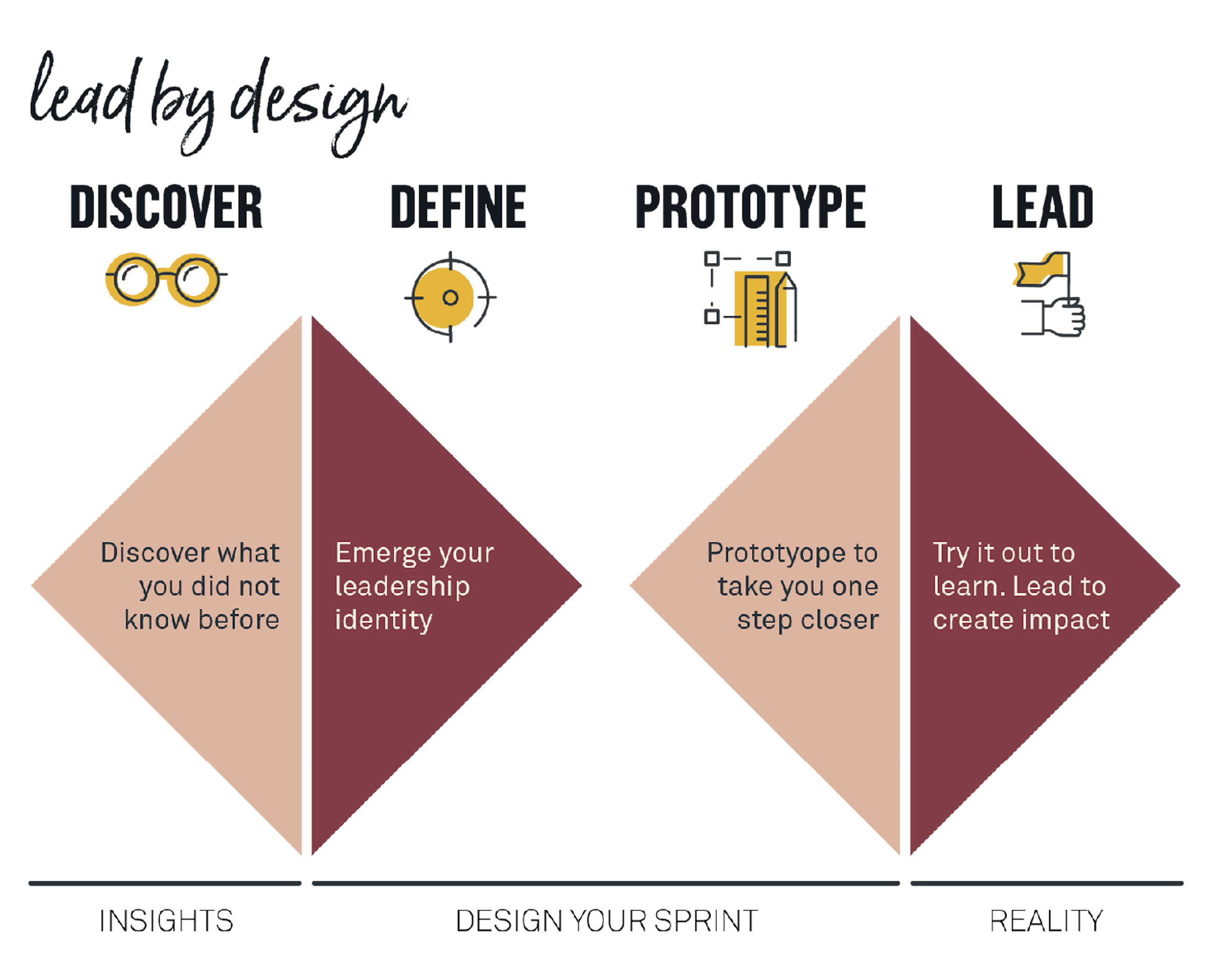Do they have anything in common?
11 November 2020
Bringing leadership development back to life to catalyse strategic transformations
Read this if you are curious about ...
Data says that your leaders are probably not ready to lead your organisation into the future. And that organisations are not doing the right things to bridge that gap. In this read, we provide a disruptive view on how leadership development must adapt to create valuable and sustainable impact for businesses.
... The approach, called Lead by design
is based on several years of experimentation and implementation with several of our vanguard clients. Tightly linked to organisational strategy and culture and inspired by how world-class innovators bring new ideas to life and products to market.
Final words. But we decided to put them first.
When we set out on this experiment in 2016, little did we know that two years later, Harvard Business Publishing, The 2018 State of Leadership Development – Meeting the Transformation Imperative would confirm that we were trailblazing through wild, highly untouched terrain in the most spot-on direction. Based on extensive studies, the report concludes that companies once and for all need to innovate and adjust their leadership development efforts to equip their leaders to drive real transformation and future-proof their organisations.
The 3 top areas highlighted in the report are:
- Build organisational agility.
L&D must identify strategically relevant interventions and experiences that it can execute now – even amid extensive change. - Deliver learner-focused initiatives.
Enable experimentation. Provide programmes that enable people to explore and practise new skills on the job. This allows people to integrate learning with work and makes learning a continual process rather than a one-time event. - Expand the definition of partnerships.
Partner up with L&D, strategy and market functions to deliver businesscritical development. Learn from innovators. Look outside your industry to organisations that have innovative programmes and approaches you can bring to your own organisation.
Let us stop tiptoeing around the issues.
In his book Dual Transformation, Harvard Business Review Press author Scott Anthony argues that the threat of disruption also constitutes the greatest opportunity that a leadership collective will ever face. But to seize that opportunity, companies need to build a phalanx of leaders with the right capabilities and mindsets.
That raises the question: is leadership development as we know it really preparing organisations to succeed in the future? Does it create a satisfactory ROI? Data suggests it is not. As in big time not.
- What CxOs say: A staggering 71% of organisations do not feel that their leaders are able to lead their organisation into the future.
- What employees say: 86% of managers see themselves as inspiring, good role models, while 82% of employees consider their leaders to be fundamentally uninspiring. Quite a gap.
- Do organisations know how to bridge this gap? No. Only 19% of organisations say they are very effective at developing leaders.
Further, 4 out of 5 organisations believe that greater innovation is needed in the leadership development sphere. On the other hand, data reveals that organisations that more directly link leadership and employee development to the strategic ambitions are typically the best-performing companies in their industries.
Organisations that view development as critical to business success are continuing to deliver top performance compared with their peers on crucial metrics such as revenue growth, market position and future growth. Leadership development is typically driven and executed in a highly traditional way – not very prone to disruptive thinking. Nonetheless, there is clearly a need for radical innovation. It is time to stop tiptoeing around this issue. It is time to stop wasting humongous amounts of money and instead make the money work for you.
Who is using leadership anyway?
Leadership development primarily tends to be an inward journey with no or too little of an outward focus. Managers have an overreliance on 360s – even if these often just scratch the surface to hidden root causes of why leaders behave the way they do. On the other hand, the market for leadership development is drowning in the abundance of formal, one-size-fits-all-plug-and-play courses, which might make you a more efficient manager but does not affect the slightest of who you are as a leader. Being a leader means that other people are actively choosing to follow you. Not because of your job description and place in the hierarchy but because of who you are, why you do what you do, and how you do it.
In 2016, we set out on a journey to turn things upside down based on the recognition that leadership is primarily not something you do for yourself but for the organisation and the followers around you – your users. To get inspiration, we turned to the ones who have the most experience of what true user focus really means: world-class innovators who develop the most sought-after products and services humanity has even seen. We wanted to find out what would happen if we would merge leadership development with proven, effective mindsets, tools and methods applied by these innovators.
Design thinking applied to behaviour change
Our hypothesis was that leaders would then have to:
- Create a true, deep understanding of external needs and problems that their leadership is solving and focus the efforts on selected key areas rather than try to do everything at once.
- Visualise, prototype and test positive leadership behaviours based on the users’ needs.
- Dare to fail, learn and iterate with the help of regular feedback to futureproof themselves and ensure there is a market demand for their services and products.
- Iterate on the journey they are embarking on to continuously “release” even better versions of themselves as leaders.
The main question we formulated was this:
How might we re-imagine leadership development to multiply its valuable and sustainable impact by learning from world-class innovators?
Ever since, we have designed and implemented such journeys with several of our bold clients, taking more than 3,000 managers through the approach and methods we have developed. The feedback we keep getting is that it truly turns leadership development as we know it upside down, creating astonishing results. Without further ado, let us dive into the geeky details for you to get a flavour of how it might taste and what it might feel like in reality.
Studies all agree: an extremely small percentage of what is taught in traditional leadership development actually gets translated into reality. The insights and learnings simply stay in the classroom, leaving a big gap in the most important learning area – the 70% – where experimentation and tackling real on-the-job challenges are supposed to take place. In fact, the vast majority of leaders would prefer to be in the driver’s seat of their learning rather than attending one-size-fits-all programmes designed according to L&D’s priorities. Although the 70-20-10 model theoretically is spot on, reality would suggest to appropriately rename it the ZERO-20-10 model.
The ZERO-20-10 model
The 70-20-10 model is a learning model that has gained a lot of attention since its development in the 1980s. Designing and running leadership development initiatives based on this approach is something most organisations aspire to, however; most of them only nail the 20% (social learning, learning from others) and the 10% (formal learning, learning through structured courses and programmes).
Transform leaders from consumers to producers
Design thinking is one of the most widely used methods to translate and transform human or business needs into valueadding products and services. It is applied in their respective fields by the majority of successful organisations such as Apple, Google, Nike, Airbnb, educational institutions, healthcare providers and NGOs all over the world. Design thinking is a non-linear, iterative process used to understand users, challenge assumptions and biases, redefine problems and create innovative solutions to prototype and test. The process is effectively executed in sprints to maximise focus, fast validation and results.
In order to find a way to turn the ZERO-20-10 model into what it was originally meant for, we merged design thinking into it. Here is what the 70-20-10 model looks with a series of leadership behaviour sprints integrated as the experimental learning experience. The 20% is social learning and primarily consists of leadership summits. Magic can be created when people meet under the right conditions, so the purpose of those is to create the direction, emotional attachment to the journey and energy required to move things forward. The 10% is the formal learning.
To enhance development, we always apply digital tools and microlearning carefully selected for the specific needs.
Lead by design
In order to truly develop new leadership behaviours, leaders are forced to give up the comfortable, laid-back and passive consumer-of-education-and-information approach, which they have oftentimes been used to attend development initiatives with. Instead, they need to adopt a producer mindset. They are now in the driver’s seat of their own development, responsible for the presence or absence of business-critical valuable outcomes.
Think of it as a P&L responsibility for the products and services you as a leader deliver. Zooming in on each sprint, the design thinking approach becomes obvious.
Hit that play button, please!
#1. Discover
Your leadership identity settles a thousand decisions later on
First of all. The purpose of such a journey is to make leaders fit for the future. To attract followers on the journey that you and the organisation are on. Not necessarily to make you a more effective formal manager – although we see that is frequently a positive side effect too.
In order to create a meaningful and relevant baseline from which to start the development (it would be surprising if Apple suddenly started to develop cheese), the leader needs to gather insights, reflect deeply and articulate a desired leadership identity. When it comes to sustainable behaviour change, it is proven that an identity-based approach outperforms an outcome-based approach big time. This means that you should not focus on what you want to achieve but on who you want to become.
We mistakenly assume that ambitious goals were the reason someone ended up as the winner, however; at the same time, there were many others with the same goals. So, the goal cannot be what differentiates winners from losers. There is a powerful difference between:
Many leaders find themselves reverting to old habits once they have accomplished their goals.
You might start trying out a new behaviour because of motivation, but the only reason you will stick with one is that it becomes part of your identity. The purpose of setting goals is to win the short-term game, and the purpose of building it into your identity is to continue playing the game.
Atomic Habits, James Clear
Shaping the leadership identity requires the leader to face a set of revealing questions. They are as much an inside-out deep dive as they are an outside-in exploration of bigger-than- you problems you could be a part of solving. The answers might confirm already existing strengths as well as uncover uncomfortable truths about differences between how you live and lead today compared to what you aspire to.
Answering these questions is highly personal and creates skin in the game for the journey ahead:
- What do you want to stand for?
- What are your beliefs, principles, world view and values?
- What is your self-image and your judgement about yourself and others?
- Who do you wish to become?
This makes the leader emotionally invested in the journey ahead and provides the best possible start to create sustainable behaviour change.
#2. Define
Nail your challenge and focus on that – nothing else
World-class innovators are super skilled at crafting a sharp value proposition for their product or service. The value proposition communicates how the product provides a solution to a specific user pain or need in a superior way. Trying to solve all the world’s challenges with one product is doomed to fail, and the market demand would soon plummet to non-existing. So, skilled innovators have learnt to solve carefully defined challenges with a laser-sharp focus.
A common flaw in leadership development is that we try to fix too many flaws/challenges at once. On any given day, you might struggle with behaviour change because you are too busy, tired, overwhelmed or a thousand other reasons. This is the reason why you need a guiding star combined with a focused step-by-step approach to get you there. Based on your leadership identity along with the needs of the organisation and your team, you define one – and only one – challenge to focus on in the first sprint.
Typically, we apply a set of non-negotiable design criteria to make sure the challenge is sharp and worthwhile to solve:
- Make a difference to your users
- Important and challenging for you (it is not about drinking less coffee although that might also be challenging for some)
- Break old habits
- Behaviour, not structure (to make it about you, not somebody else)
- Bring you closer to your leadership identity in your everyday life
By now, you have defined your challenge. Let us see how you will bring it to life.
#3. Prototype
Be prepared to kill your darlings
Challenges can often be solved in more than one way, depending on the angle from which you view the problem and who you ask. This is where the power of design thinking beautifully blends analysis and creativity together.
To make sure not to jump too quickly to a conclusion (e.g. “I probably just need to give more feedback – that should solve the engagement issue”), the leader is forced to use his/her creativity and apply divergent thinking to come up with a set of different options that individually would solve the challenge.
Falling in love with one’s initial idea and refusing to let go no matter what is one of the most common pitfalls when developing services for users. First, after having explored a set of options, the leader is able to make an active choice about which option would likely create the most impact for the users (e.g. mastering the art of giving feedback, managing tough conversations, inspiring visionary action, empowering more autonomy etc.).
Prototyping the behaviour typically consists of asking yourself questions such as:
- Why do I really want this?
- Which small wins would prove that I am making progress?
- What do I need to learn? What do I need to unlearn?
- How can I reduce friction associated with good behaviour and increase friction with bad behaviour?
- What does it look and feel like for my users and myself when I succeed?
To spark breakthrough ideas and make the ideas extremely tangible, we always use strong visualisation tools, storytelling and sketches to push leaders outside ordinary thinking patterns and comfort zones. Combined with the hardcore data points the leaders have gathered so far, they are now able to base their prototypes on a mix of intuitive, creative and analytical thinking.
#4. Lead
Test to learn and create an impact
The time has come to make your first market test of your product. In order to learn as much as possible, you need to maximise the number of “tests” to make. Therefore, the leader outlines several different typical daily situations (one-on-one meetings, executive management meetings, team meetings, lunches etc.) where it would be meaningful to test the desired leadership behaviour. We call this behaviour programming. Studies have shown the differences in outcome between people who have an intent to make a change vs people who have an intent and a clear plan for how to do it.
“When [situation X arises], I will [perform behaviour Y]”
One study showed that people who did not only rely on their motivation to change but also programmed their behaviour in this way increased the success rate from 35% (control group) to 91% (the group which programmed their behaviours).
Many people think they lack motivation, but what they really lack is focus and clarity. Since we also know that new leadership behaviours form based on frequency and not based on time, we ask the leader to code multiple situations where he/she will be able to practise the new behaviour. The leadership behaviour sprint provides a setting and time frame from which the leader sets out to encounter as many real-life situations as possible to validate the need and value of his/her prototyped behaviour. During the sprint, the leader refines the prototype by gathering feedback from multiple sources, enabling the leader to continuously refine the way in which he/she takes steps towards his/her leadership identity.
For the users, it is crucial to success that you are open about what you are trying to achieve. This is the only way you will find out what they think. Hiding products behind the shelf is typically an unwise go-to-market approach. By sharing the human story of why you are on your specific change journey creates openness and a vulnerability that serve the leader’s purpose well.
The lead part is the big chunk of the leadership behaviour sprint. It is when you are out there in reality. The 70%. Out there on the battlefield, the notion of motion vs action plays an important role in whether you will succeed.
When in motion, you are strategising and planning. Good things, but they do not produce any results. We are lured by a feeling of progress when in reality nothing happens. We are often so focused on figuring out the best approach that we do not get around to doing anything. During leadership behaviour sprints, we are not interested in motion. Action is the only valid currency that will deliver an actual outcome. It does not help how many times you talk to a personal trainer. Motion will never get you in shape. You need to do the reps yourself.
When you are out there on your own, we know how important it is to have a safe space to share any thoughts and feelings that may arise. That is why we always form leadership labs with a small number of other leaders. It is an environment where we put a lot of effort into building deep trust. Trust to inspire. Trust to challenge. Trust to give honest feedback. Trust to make you all succeed.
The virtual space is another safe space and a point of learning. New leadership development software is key to keeping it all top of mind in a busy daily work life. For the purpose of regularly touching base with the leadership lab, microlearning or collecting feedback from users, both analogous methods and digital software can be used. To enhance development, we always apply digital tools and microlearning that are carefully selected for the specific needs.
That is it
Based on the development the leader has made during the sprint, he/she is even more well equipped to enter the next sprint.
Implementation nuggets
We certainly hope that we have provoked some new thoughts and ideas. Before you re-enter the real world, here are some tips and tricks we have gathered along the way.
Major organisational shifts achieved
Ethnographers who have studied this approach conclude that two major shifts are achieved:
- A greater responsibility for one’s own leadership to drive the desired culture and behaviours and deliver on the strategy regardless of whether it is the CEO or a plant manager.
- A major cultural shift to support the strategic ambitions created through powerful movements where leaders and teams are involved.
Organisational enablers or obstructions
The culture and structure lie as a layer around the process. They determine which behaviours are attractive to leaders in a given context. In some cases, aspects of culture or structure may have to be re-imagined in order to design the world where it is easy to do the right thing.
Scope strategic powerful movements
Organisations can design this kind of initiative however small or large they want. One manager or all managers. One sprint or several sprints. All depending on the ambitions and desired effect. Evidence is clear: when leadership development is tightly connected to the strategic agenda, it creates a lot more value for everybody involved – also on hardcore numbers such as revenue growth, market position and future growth. It changes not just the leadership skills but also the culture and the speed at which the strategy implementation is evolving. Common strategically relevant sprint themes create a powerful force and a movement throughout the organisation.
Involve users – for real
Key to success is to involve the users throughout the journey to create a critical mass of valuable data and to create a true link from leadership development initiatives to the real daily work. We focus a lot on creating transparency and daring to give and receive valuable feedback. This also creates massive engagement.
A sustainable method
Working with leadership development in this way becomes a norm that stays, according to the companies we have been working closely with. An expectation from users, a way to advance culture and strategy and a leadership mindset to think about development.
Sources
Beer, M., Finnström, M. & Schrader, D. (2016). “Why Leadership Training Fails − and What to Do About It” in Harvard Business Review, October 2016.
Clear, J. (2018). Atomic Habits: An Easy & Proven Way to Build Good Habits & Break Bad Ones, New York: Avery (Penguin Random House).
Harvard Business (2018). The 2018 State of Leadership Development: Meeting the Transformation Imperative, Boston: Harvard Business Publishing.
Hougaard, R. & Carter, J. (2018). The Mind of the Leader: How to Lead Yourself, Your People, and Your Organization for Extraordinary Results, Boston: Harvard Business Publishing.
Kotter, J. P. (2007). “Leading Change: Why transformation efforts fail” in Harvard Business Review, January 2007.
McGoff, C. (2017). “Why Leadership Development Programs Don’t Work (And What Does): Leadership development should be approached like a fitness routine” published by Inc. on 29 September 2017.
Pearse, C. (2018). “Why Leadership Development Is Still Stuck In The Dark Ages” published by Forbes on 19 November 2018.







